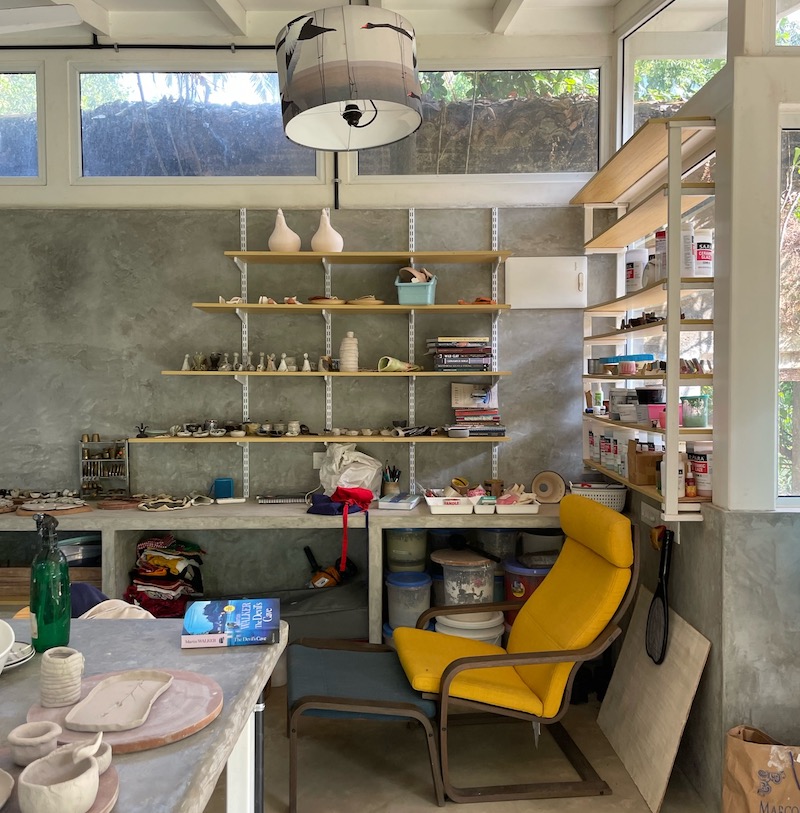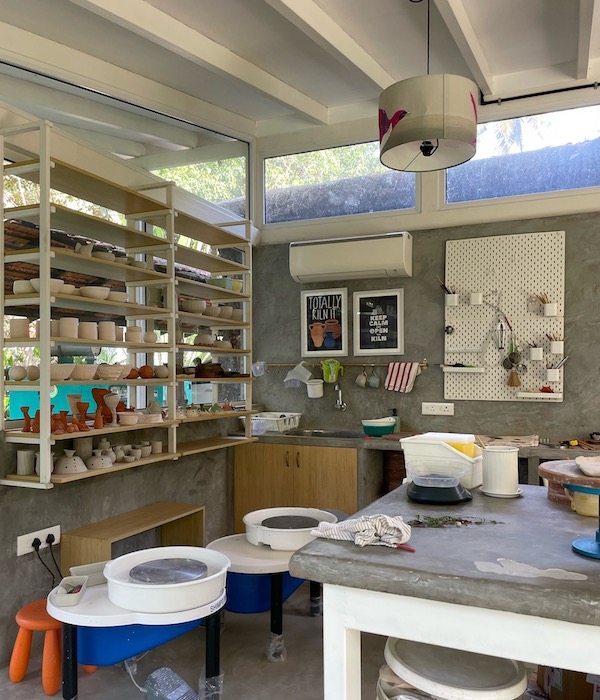Pottery maker Kavita Nair wakes up every morning to the music of the birds in Anjuna, a village in the state of Goa, India. Leaving a corporate job in Mumbai to enjoy a second career as a business advisor, vacation rental host, and emerging pottery artist, Kavita found the perfect solution for pottery-making by building a 16 x 24 foot she shed studio.

In 2020, life took a sharp turn for Kavita Nair. The longtime corporate executive left her job in Mumbai and with her young daughter and husband Manoj, headed south to a beachside region in Goa. They bought a home with a guest house, and decided to offer experiential homestays. Last year, Parijaat Goa, their two-unit bed and breakfast was featured in Conde Nast Traveler. Greeting guests from around the world has become both a joy and a sound income stream for the family.
A year or two later, Kavita began experimenting with pottery making. “After years of being a ceramic ‘hoarder,’ I ventured into playing with clay,” she explains. Pulling and pressing and forming the clay lets her explore the messy, unstructured side of herself that working in a huge corporation never could. Soon it became a passion and Kavita looked around for a place to ply her new craft.

Building a Pottery Shed
At first Kavita considered creating a studio in her own house. She had a makeshift studio that connected her daughter’s room with hers and Manoj’s. But then there was “Mr. Burnie” to consider.

Mr. Burnie happens to be the kiln Kavita invested in, turning her pottery making into more than a pastime. Kilns are heavy, hot, and sometimes temperamental. “Like most of the people I have known all my life!” Kavita laughs.
“He is the primary reason I built the studio,” she continues. While waiting on the kiln’s arrival, Kavita took mouse to PowerPoint to draw her shed design.

The studio reflects its location in western India, the unique needs of pottery making, and the aesthetic to inspire an artist. Kavita wanted a footprint that was large enough to design important areas for casting, creating, storing, and baking. She also wanted an area for sitting, to relax and think about her next project or simply sip a mug of tea.
Modern and Bohemian Combined
Your first impression of Kavita’s finished studio is one of airiness and light. A spectacular front entrance under the shed’s mono-sloped roof consists entirely of glass. Two large sliding doors open within sidelights on each side. The widest wall of the studio faces front, so it maximizes the shade that comes from the large tamarind tree near the entrance.

At the rear of the studio is a solid wall of brick covered by a cement coating, which houses the air conditioner. It also provides insulation and needed wall space for shelves. Narrow privacy windows line the top of the wall, however, so light and pattern from the treetops come through. The sloping roof has generous eaves, about four feet in front and on the sides. They offer additional shade and protection while working outside.
Concrete is an excellent material to use for pottery studios. On the floor it is sturdy, stainproof, and easy to clean. On the working table, a concrete surface is ideal for manipulating the clay; it stays cool and doesn’t shed particles as you work.

Plentiful open shelves showcase Kavita’s finished creations. The windows on the right and left walls are lined with shelves and filled with pots, bowls, sculptures, and vases of all sizes, shapes, and colors.
Unexpected Gifts
Kavita knew her pottery studio would fufill something large inside of her. Each piece evokes a tiny bit of her own life or her relationship with family and nature. “The things that I create come from memories like the ‘bhatukli’ my daughter played with, things from my life and travels, and of course from the nature that surrounds my being,” she says.

However, she didn’t anticipate the delight it inspires in the people who come to stay. Everyone wants to visit the pottery studio and so Kavita now offers basic workshops for guests. They can make something and take a little piece of Parijaat Goa home with them.




Leave a Reply